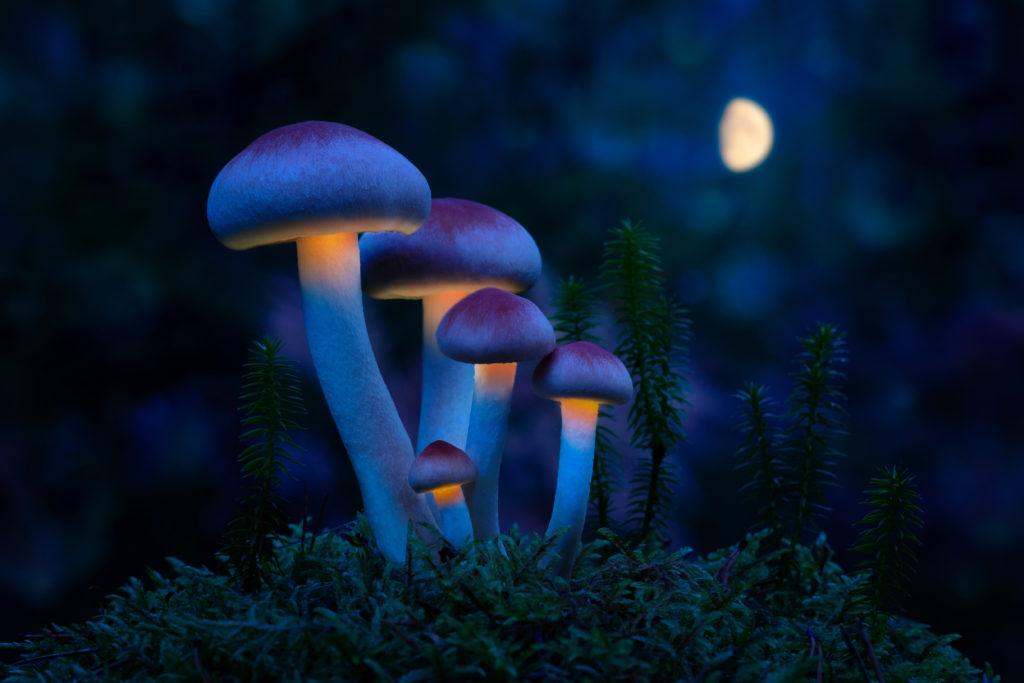
In January of this year, Psychedelic Science Review reported on a study by Claudius Lenz of the Hans Knöll Institute and his research team which revealed the mechanism by which the psilocybin in magic mushrooms turns blue in response to injury or stress.1 Now, Dr. Lenz’s team including Alexander Sherwood of the Usona Institute and Dirk Hoffmeister, also of the Hans Knöll Institute, have published a paper saying, “[additional] Experimental evidence did not support the original hypothesis” about the origin of the blue color.2
Specifically, the team said of the current study, “We sought more profound insight into the oxidation chemistry of 1 [psilocin] by precise characterization and analysis of the individual chromophores produced by its initial dimeric products.”
The Original Hypothesis
Lenz et al.’s 2019 paper identified two enzymes that degrade psilocybin in a cascade reaction.1 They explained that the degradation prepares the molecule for oxidative oligomerization that leads to the formation of the blue compound. They concluded, “the blue color is due to a heterogenous mixture of quinoid psilocyl oligomers, primarily coupled via C-5.”
What Changed?
In the current study, “ring-methylated [psilocin] derivatives were synthesized to provide stable analogs of [psilocin] dimers that could be completely characterized. The chemically oxidized derivatives were spectroscopically analyzed and compared to computationally derived absorbance spectra.” From the data they generated, Lenz et al. concluded that,
Experimental and computational evidence derived from [psilocin] as well as from methylated derivatives as surrogates proved the quinoid chromophore of the 7,7’-coupled dimer of [psilocin] to confer the blue color on injured mushrooms.2
So, Magic Mushrooms Turn Blue. Who Cares?
Aside from human curiosity, understanding why these mushrooms turn blue may not seem a high priority in psychedelic science research. However, these bits of information contribute to scientists’ understanding of the magic mushrooms’ natural world. Nature can keep her secrets well and being in the dark about how some of these processes work leaves blank knowledge areas. These blanks become roadblocks that can thwart further research and stall progress.
Also, consider the impact of Lenz et al.’s latest bluing mechanism study on potential large-scale magic mushroom cultivation practices. A couple of interesting questions are 1) If bluing causes a loss of potency, can it be reduced or prevented? 2) What other physiological mechanisms in magic mushrooms may be impacted (positively or negatively) as a result of the bluing reaction?

This isn’t a science article. It’s a sad blog entry. Hope you didn’t get paid for this crap
“When the sands are all dry, he is gay as a lark,
And will talk in contemptuous tones of the Shark:
But, when the tide rises and sharks are around,
His voice has a timid and tremulous sound.”
— Lewis Carroll, Alice’s Adventures in Wonderland, Through the Looking-Glass
Elegantly handled.
I, for one, greatly appreciate your contributions and updates (and know I’m not alone).
Your upkeep with the literature is invaluable.
Have a great remainder of your week!
This is clearly a scientific post, and I can’t reconcile the vitriol of this comment with anything from the article. This dude has issues, hope the author doesn’t listen to them!
That’s very interesting.
I have read that damaged wood loving psilocybes may have a greater chance of producing the mysterious “wood lovers paralysis” . Could creation of these 7, 7′ psilocin dimers or oligomers from trauma play a role here in the pathophysiology of this mysterious condition?
Whole body cryotherapy also helps to mitigate the paralysis immediately.
WLP in R hand, jaw, sublingual muscles, and eyes experienced this morning after a night with 9 dried grams of cyanescens.